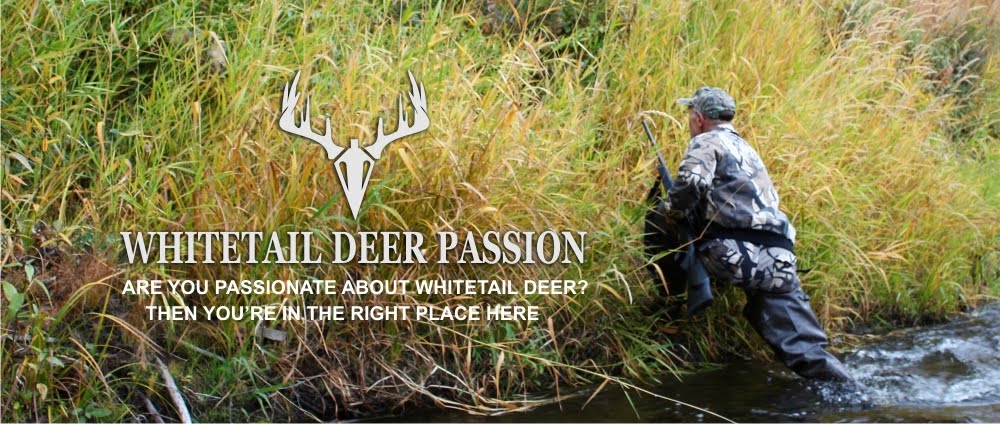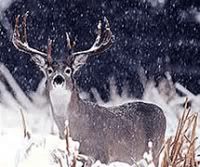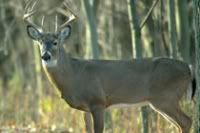- Whitetail Deer (Odocoileus virginianus)
- Weapon Choices for Deer Hunters
- Field Aging Bucks
- CWD (Chronic Wasting Disease)
Whitetail Deer (Odocoileus virginianus)
 Description:
Description:The whitetail deer is without question the most favourite game animal of North America. There are two name spellings “Whitetail deer” and “White-Tailed-Deer” for this game species. Most hunters refer to the whitetail deer affectionately as "whitey". The whitetail deer is a relatively small animal with short ears and relatively long tail. The name comes from the white underside of the tail and backside. If the whitetail deer is alert it lifts its tail (called flagging) and the white “mirror” is displayed, thus the name whitetail deer. The males (bucks) have antlers consisting of two main beams, one on either side of the skull, these main beams swing from the skull back and then in a semi circle to the front. Several usually unbranched tines (points) come of the main beam. Depending at the area where whitetail deer’s come from their colour can vary from dark brown to reddish brown. Usually in the southern parts of North America the whitetail deer are reddish brown and of slender stature. In the northern parts like Canada the deer are darker brown and of a stouter stature with heavier mass in the antlers. The antlers are a bony structure, which is shed in the winter. Depending on range area this can be as early as November or as late as January. The antlers begin to grow back in the spring when the deer has access to a lot of nutritious food that is needed for the growth of the antlers.
Habitat & Diet:
Unlike other deer subspecies the whitetail deer lives in a wide range of habitats it is this adaptability that made the whitetail the most successful gmae species in North America. Unlike to some other deer species the whitetail der is not a migratory animal but stays in a relaitvily, depending on the availability of food, in small territory. From the swampy river bottoms of Alabama to the hardwood lots and agricultural fields of the American Midwest right up to Canada’s pine forests and rocky the slopes the whitetail deer calls a wide range its home. Unlike common believe the whitetail deer is not a deep forest dwelling animal. They like semi open brushy habitat near and around rivers and wood lots where they can find choice browse and retreat quickly into the protective cover again. The whitetail deer’s diet is as varied as its habitat range and changes from season to season. The most preferred food, where available, is agricultural crop such as corn and beans. Deer also eat grass, berries, fruit; an old apple orchard is irresistible to any deer. Other so-called woodland food sources are acorns, persimmon but also saplings, fungi, bark and many other things. Like all ruminants the whitetail deer has two main feeding times within 24 hours. These are early in the morning at dawn and then late in the day at dusk again. During the day the deer likes to lay on an elevated point, such as a ridge top, as chews its cut.
Reproduction:
The whitetail deer are polygamous. The rut (breeding) phase begins in early fall and continuous trough the early winter. The start of the rut varies from region to region. For example, in the southern part of the U.S.A. the rut may start as early as late August early September. Whereas is Canada the rut may start as late as the beginning of November. In the past it has been believed that the beginning of the rut is connected with the moon phase. Today we know that the rut is triggered by a sharp trop in the temperature. It can be safely estimated that the beginning of the rut usually begins around the time of the first cold snap or frost of the year. In most parts of North America the female (Doe) is breed by the end of January. After a gestation period of about 7 month one to two young deer (fawn) are born. In the first 10 to 14 days the mother will hide the fawns usually in tall grass and returns to them several times a day to nurse them. The fawns are odourless in the first two to three weeks of their life and when the mother is not with them they fall into a motionless, coma like, state and thus can stay undetected from most predators. To further enhance staying undetected the fawns are born with a white doted fur and a light reddish brown base colour that makes them almost invisible in tall grass or brush, even at very close distance. At about two weeks of age the fawns are strong enough to follow their mother but will retain the spotted fur until they molt for the first time in early fall by which time they are usually weaned too. Sexual maturity is usually reached not until the second year by a doe and the first year by a buck. However, if conditions are excellent a female fawn may come in her first oestrus cycle in the first year and will give birth in the following spring. It is however rare that a whitetail deer’s first-born fawn will survive longer than a few weeks.
Common Hunting Methods:
Whitetail deer are pursued with rifle, slug shotgun, bow and arrows, handguns and muzzleloaders. There are many different tactics that can be employed when trying to get a whirly whitetail harvested. These include spot and stalk, deer driving, stand hunting, blind hunting. The combinations of rattling, scent lure, baiting and calling are sheer endless. I can say with all confidence that for no animal have been so many specific hunting strategies developed than for the whitetail deer. Depending on the area and the structure of the land from the deep dark forests of Michigan, the cornfields and small woodlots of Illinois to the wide open grass lands and river bottoms of Texas and Colorado, there seems to be a special strategy and tradition to hunt this most popular of all game animals.
A keen sense of smell and a good eyesight mixed with the ability to blend completely in to the background of their surroundings make the whitetail deer extremely challenging to hunt.
------------------------
Weapon Choices for Deer Hunters
Get a few hunters together in a deer camp and start talking about the best weapon choice for deer hunting and you soon will have, at times, a heated and opinionated debate going. Each hunter has his own favourite weapon choice and within that weapon category his favorite set up. There is no one single best weapon for every situation.
There are many variables to be considered in choosing a weapon for deer hunting. Such as the terrain the hunter hunts in, what hunting method he prefers and finally what's the hunters personal preference in weapon type, stile and even brand name. One aspect that all weapons have in common is that they are only as good as the person operating them.
If I could give only one single advice to every beginning hunter, and seasoned hunter for that matter, then it is this.
Before you make you decide to buy any weapon for hunting purpose invest a considerable amount of time to research and try as many different weapons as possible. Forget for a moment the brand name and choose a weapon which fits you physic and feels comfortable to carry and handle. Once you get the weapon of your choice home don't put it in the cabinet for all to look at it. Instead keep practicing with it all year round and spend as much time to get to know your weapon as possible. In order to become a proficient shooter you have to be as familiar with your weapon as you are with yourself. In fact the weapon has to become an appendage of your body. Practice the one shot mentality, because under field conditions that is all you will get.
The following list is by no means complete but rather should be viewed as a rough guideline. Also make sure that you study the hunting regulations of the area, state or province you wish to hunt. The hunting regulations often will have specific requirements for weapons, their storage and transport.
Rifles - there are many to choose from, I just listed a few here.
Light End:
.243 Winchester, 6mm Remington, .250 Savage,.257 Roberts, .260 Remington, 30-30 Winchester.
Medium:
.270 Winchester, .280 Remington, 7x57 Mauser, 7mm-08 Remington, .284 Winchester.
Heavy End:
.308 Winchester, 30-06 Springfield, 7mmRemington Magnum.
Authors note. -My personal choice is a 7mm-08 Remington, which I use in forested areas and other spaces with thick vegetation where shots are at close range. As a long-range rifle for deer in the open plains I like the flat shooting 7mm Remington Magnum.
Pistols (Handguns are not legal in every U.S. State and Canadian Province. Make sure you read the regulations before taking a handgun into the field.)
Light End:
.357 Magnum.
Medium:
.41 Magnum, .44 Remington Magnum.
Heavy End:
.454 Casual
Bows (This includes modern compound and traditional recurve and long bows. Read the hunting regulations for specific recommendations of draw weight and let-off percentages, such regulations can vary from state to state or provinces. In most areas it is legal to use a bow with a draw weight between 40lb. to 45lb. minimum.)
Light End:
40lb. pound draw weight.
Medium:
45lb., - 50lb.,- 55lb. draw weight.
Heavy End:
60lb.,- 65lb.,- 70lb. draw weight.
Authors note. - My choice is a 65lb. compound bow with a 75% let off. For me this bow is easy to draw and hold when I have to wait for the perfect shot at full draw.
Crossbows (The very exiting news is that more U.S. Wildlife Agencies legalize this traditional archery weapon for all hunters to be used as a very effective hunting tool. However, I recommend strongly that you check with your local wildlife agency about the legal use for non-physically challenged persons.)
Light End:
110 pounds draw weight.
Medium:
125 pounds draw weight.
Heavy End:
175 pounds draw weight.
Authors Note. - Personally I prefer the heavy end cross bow to hunt with. But generally speaking any crossbow is a very effective weapon to hunt deer with. I am very exited that there are more opportunities available to hunt with this weapon that has an undeserved negative reputation.
Muzzleloaders (This includes all muzzleloader firearms, including black powder handguns, modern in-lines, percussion cap locks and flintlocks. Please check with the hunting regulations for more detailed information, regulations and special seasons.)
Light End:
.45 Calibre.
Medium:
.50 Calibre
Heavy End:
.54 Calibre
Authors note. - The .50 calibre muzzleloader is a very good choice for deer hunting with round balls, conical bullets and sabboted pistol bullets. It has moderate recoil depending on the load combination.
Shotguns
Light End: 20 gauge.
Medium: 12 gauge.
Heavy End: 10 gauge.
Authors note: - My choice of shotgun is a 12 gauge dedicated (centre fire rifle style) slug gun with sabboted slugs. Personally, I do not recommend using "buck shot" as I feel it is not as efficient as a well-placed slug. Also a slug gun is a short range weapon shots should be kept within 100 yards. Slug guns are perfect "brush guns".
-------------------------------------
Field Aging Bucks
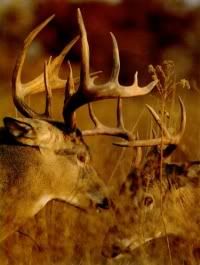 Here is a quick and easy guide on how to field judge a whitetail deer buck’s age.
Here is a quick and easy guide on how to field judge a whitetail deer buck’s age.There are some basic body "shapes" that help identify a buck's age, but you kind of have to "read between the body size." In essence, you have to ignore the over-all body size and look for specific characteristics.
Just remember that body shape is going to change dramatically from the late summer and opening of bow season to November (rut). Even older bucks look more "meek" in late summer. There is also a difference in a buck’s body shape and size in different regions of North America. For example a southern United States buck compared to a Canadian buck of the same age looks much smaller and dainty. For comparison see the two pictures below side by side of a Saskatchewan buck (top) and an Alabaman buck (bottom) of about the same age class.
******************
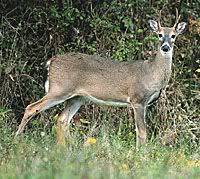 Yearling Buck
Yearling BuckFor yearling bucks, even in Canada where their body weight can be high, yearlings still have the look of a large doe with antlers.
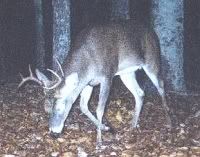 2 1/2 Year old Buck
2 1/2 Year old Buck2 1/2-year-old bucks are more muscular in chest, but not as much more in hams than a yearling, but they will have a large neck near the rut. In fact, the easiest way to identify a yearling from a 2 1/2 is the neck. If it has a big thick neck, it is not a yearling.
 3 1/2 Year old Buck
3 1/2 Year old Buck3 1/2-year-old bucks look very much like thoroughbred race-horses. Very trim waist, but shoulders and hams are very muscular.
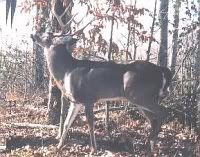 4 1/2 Year old Buck
4 1/2 Year old Buck4 1/2-year-old bucks are really at the peak of their game. Muscular in hams and shoulders, but belly is starting to get big, with some sag. The neck of a 4 1/2 is so large it kind of blends straight into the chest with little definition between the two, as in no destinct line between the end of the neck and the beginning of the chest.
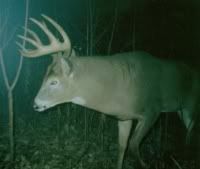 5 1/2 Years and older Bucks
5 1/2 Years and older Bucks5 1/2+ year-old bucks have a lot of belly sag and the back starts to become swayed. Neck is huge with no definition between neck and chest.
----------------------------------------
CWD (Chronic Wasting Disease)
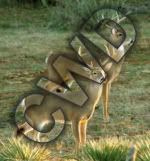 Here at Outdoors with Othmar Vohringer and Whitetail Deer Passion we recognizes the current threat that chronic wasting disease (CWD) poses for the deer, elk and perhaps other wildlife plus to the heritage of hunting big game in general that could occur if this illness should spread further. In several regions of North America this threat has become already a sad reality. This is why we here at Outdoors with Othmar Vohringer and Whitetail Deer Passion have compiled an informative resource of information so that the visitors to our website can learn more about this threat and what they can do to help in the prevention of the spread of CWD.
Here at Outdoors with Othmar Vohringer and Whitetail Deer Passion we recognizes the current threat that chronic wasting disease (CWD) poses for the deer, elk and perhaps other wildlife plus to the heritage of hunting big game in general that could occur if this illness should spread further. In several regions of North America this threat has become already a sad reality. This is why we here at Outdoors with Othmar Vohringer and Whitetail Deer Passion have compiled an informative resource of information so that the visitors to our website can learn more about this threat and what they can do to help in the prevention of the spread of CWD.As hunters and conservationists we at Outdoors with Othmar Vohringer and Whitetail Deer Passion feel it is our duty to our fellow outdoor and hunting enthusiasts to provide the information available without the usual hype, rumours and hearsay. Instead we provide the facts, as they are known to us from reputable sources in an effort that you can take the necessary precautions and to learn what various state and province agencies in the USA and Canada are doing to combat this problem. For most hunters, especially those who hunt in areas where CWD has not been found do not be concerned about CWD and still can enjoy the upcoming hunting season. But we at Othmar Vohringer Outdoors would like to encourage all hunters who care about wildlife and conservation as much as we do, to get as much information and education about this illness as possible, to take all the necessary precautions and help their local wildlife management agencies in any way they see fit in preventing the spread of CWD in an effort to secure our priceless natural renewable resources for generations to come.. Thank you for being a true hunter and conservationist, we count on you and so do our children and future generation hunters.
Bellow we provide you with the answers to most CWD questions.
**************
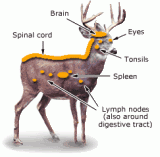 What is CWD?
What is CWD?CWD is a neurological (brain and nervous system) disease found in deer and elk in certain geographical locations in North America. The disease belongs to a family of diseases known as transmissible spongiform encephalopathises (TSE) or prion diseases.
This disease attacks the brain of the infected deer or elk and produces small lesions that result in the death of the animal. While CWD is similar to mad cow disease (BSE) in cattle and as scrapie in sheep, there is no known relationship between CWD and any other TSE of animals and, or people
.
How is it spread?
It’s not known exactly how CWD is spread. It is believed that the agent responsible for the disease may be spread both directly (animal to animal) and indirectly (soil or other surface to animal). It is thought that the most common mode of transmission from an infected animal is via saliva and feces.
Where has it been found?
CWD is known to infect wild deer and elk in north-eastern Colorado and southern Wyoming, and wild deer in western Colorado, western Nebraska, south-western South Dakota, south-central New Mexico and west-central Saskatchewan. It has been diagnosed in game ranches in Colorado, Nebraska, South Dakota, Montana, Oklahoma, Kansas, Alberta and Saskatchewan.
Is it dangerous to humans?
There is currently no convincing evidence that the agent of CWD affects humans. However, public health officials recommend that human exposure to CWD agent be avoided as they continue to research the disease.
What precautions should hunters take?
Health officials advise hunters not to consume meat from animals known to be infected with the disease. Boning out meat is recommended. In addition, they suggest that hunters take normal simple hygienic precautions when field dressing carcasses.
How can you tell if a deer has CWD?
Infected animals may not show any symptoms of the disease. In some stages of the disease, however, infected animals begin to lose bodily functions and display abnormal behaviour such as staggering, disorientation or standing with very pore posture. Animals may have an exaggerated wide posture, or may carry the head and ears lowered. Infected animals become very emaciated (thus wasting disease) and will appear in very poor body condition. Infected animals will also often stand near water. Drooling or excessive salivation may be apparent. Note that these symptoms may also be characteristic of diseases other than CWD.
What should I do if I see a deer with CWD?
Unless your state or province wildlife agency or other appropriate authority has issued other instructions and/or regulations, you should accurately document the location of the animal and immediately contact the nearest officer or employee of the State or Province Wildlife Agency. Do not attempt to contact, disturb, kill, or remove the animal.
Can I have a deer tested?
In general, the answer is no if you live in an area where CWD has not been documented. Testing is currently only available in areas where CWD has been detected in wild deer. Much effort is being devoted to increasing the laboratories that are certified to do the testing.
Is the meat safe to eat?
While the agent that produces chronic wasting disease in deer and elk has not been positively identifies, there is strong evidence to suggest that abnormally shape proteins, called prions, are responsible. Research completed to date indicate that the prions accumulate in certain parts of infected animals-the brain, eyes, spinal cord, lymph nodes, tonsils and spleen. Based on these findings, hunters are recommended to not eat meat from animals known to be infected with CWD. Hunters in CWD areas are also advice to bone out their meat and to not consume those parts where prions likely accumulate.
What's being done to combat CWD?
Efforts to address CWD are accelerating rapidly. In facilities with captive animals known to have or to have been exposed to CWD, management is concentrating on quarantining or killing of every animal and burning of all carcasses. In some cases around captive populations, double fencing is recommended to prevent direct contact between captive and wild animals.
In wild populations, the management option recommended is to reduce the density of animals in the infected area to slow the transmission of the disease. This is being done by selective culling of animals suspected to have been directly exposed to this disease. In Colorado, Nebraska and Wisconsin large numbers of animals are being killed to reduce density of animals and thus slow the transmission of the disease.
There is still a large need for research on the disease as many questions go unanswered. There s also a need for increased funding to support additional laboratories for testing animals for the disease. Just about every U.S. State and Canadian Province wildlife agency is now planning an increased effort at surveillance to detect if CWD is present.
Many state and province agencies have banned the importation of deer and elk into their state or province.
Some U.S. States and Canadian Provinces have also halted intra-state/province movement of deer and elk has banned supplemental feeding programs. Colorado has implemented regulations that allow only boned meat, quarters (without spinal column or head) or processed meat from deer or elk to be transported out of certain areas with CWD. Clean skull plates with the antlers attached can also be removed from an infected area. Check with a state/province wildlife agency in the state/province where you hunt to determine if they have enacted similar restrictions.
For more up-to-date information please visit:
The CWD.Org. Website
Chronic Wasting Disease is a joint project of the Boone and Crockett Club, the Mule Deer Foundation and the Rocky Mountain Elk Foundation. These non-profit wildlife conservation organizations formed the Chronic Wasting Disease Alliance in January 2002 to address CWD. Other organizations have since joined the Alliance.
Updates about CWD on this Blog:
West Virginia CWD
Infectious Prions Found in Deer Meat
